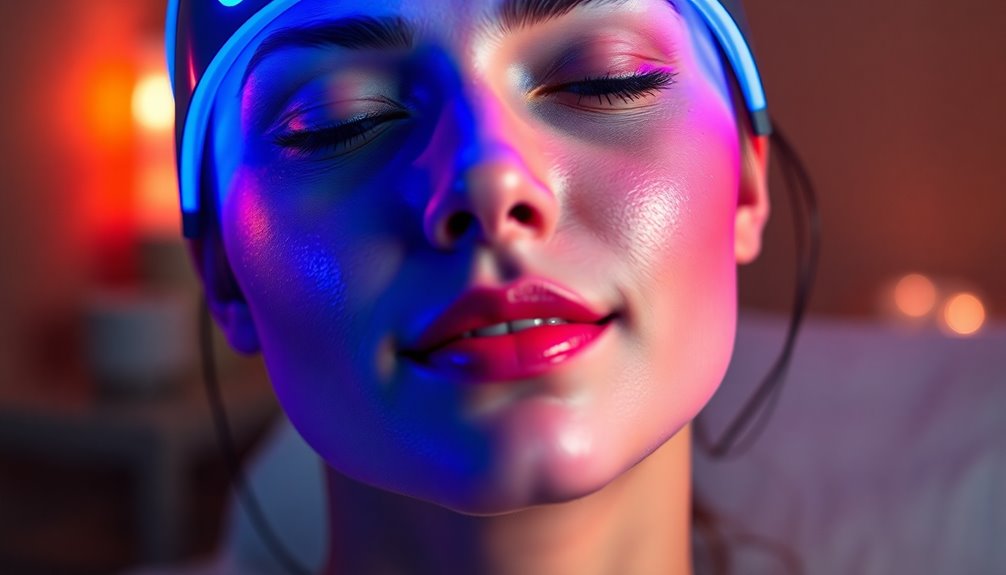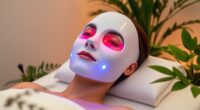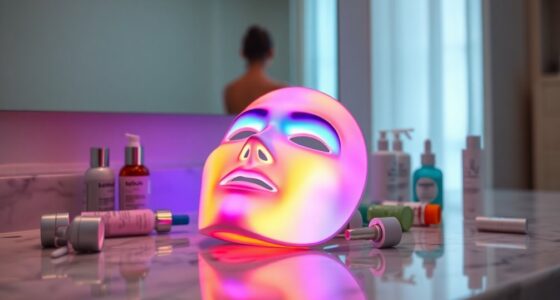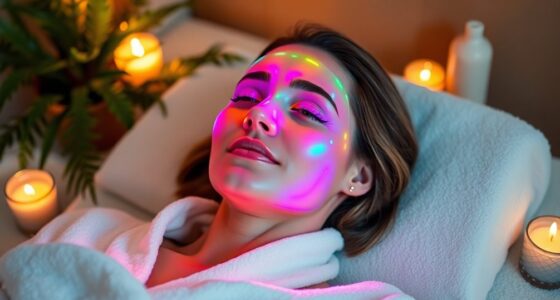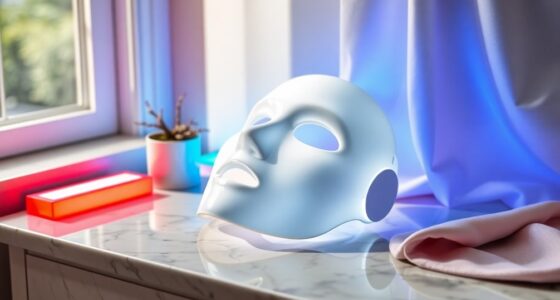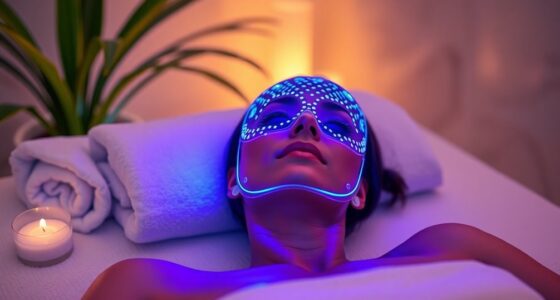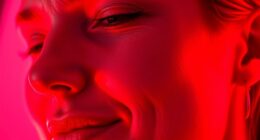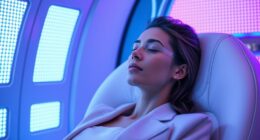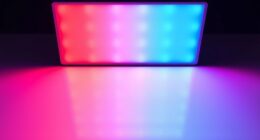Yes, LED light masks can work for improving your skin. They use specific wavelengths of light to boost collagen production, helping with wrinkles and acne. While results vary and at-home versions offer subtler improvements compared to professional devices, consistent use can lead to noticeable changes in skin texture. Just be mindful of safety measures to avoid irritation. Want to know more about how they compare to in-office treatments and who should use them?
Key Takeaways
- LED light masks can promote collagen synthesis and improve skin texture, but results are typically subtle and require consistent use.
- Red light targets wrinkles and stimulates collagen production, while blue light helps reduce acne-causing bacteria.
- Professional devices generally offer more significant results than at-home masks due to higher intensity and quality.
- Users may experience side effects like skin irritation or redness; adherence to safety guidelines is crucial.
- FDA clearance is important; ensure you choose a device that meets safety and efficacy standards for effective results.
What Are LED Face Masks?
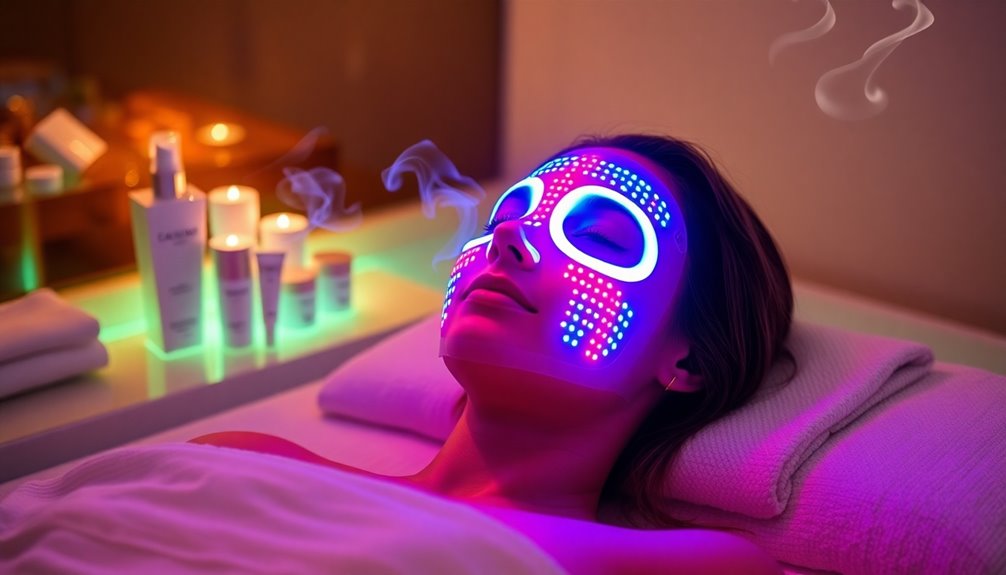
LED face masks are innovative skincare devices that use light-emitting diodes to trigger biochemical reactions in your skin cells.
These masks promote collagen synthesis, making them popular for their anti-aging benefits. They come in various colors, with red light targeting wrinkles and fine lines, while blue light helps combat acne.
Originally reserved for professional treatments, LED face masks are now widely available for home use, allowing you to enjoy their benefits at your convenience.
Prices can range from under $50 to nearly $2,000, depending on the brand and technology.
Regular use can lead to subtle improvements in skin texture and overall appearance, although at-home versions may not be as effective as those used in dermatological offices.
How Do LED Face Masks Work?
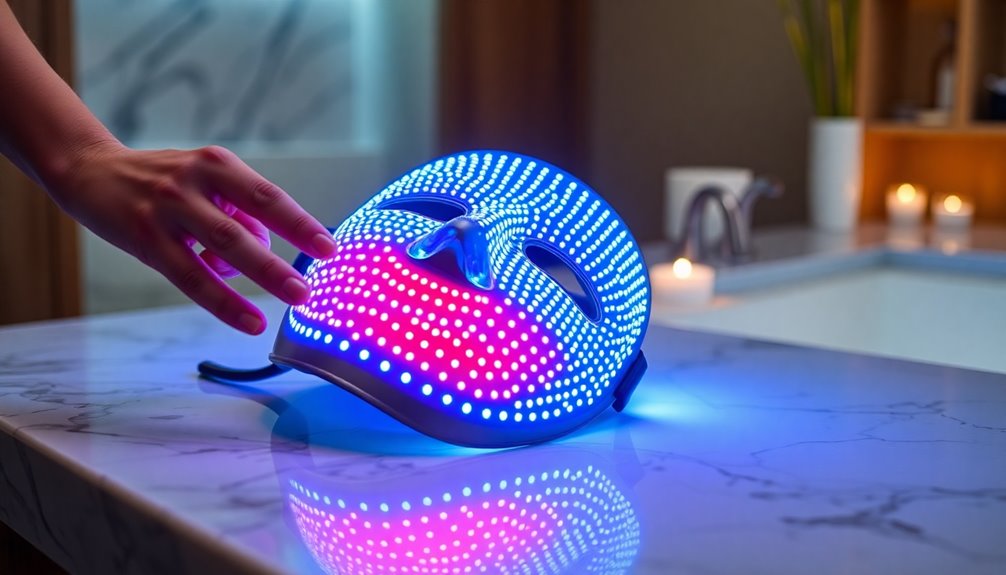
LED face masks work by emitting specific wavelengths of light that penetrate your skin, triggering biochemical reactions.
Red light boosts collagen production for improved elasticity, while blue light targets acne-causing bacteria.
Understanding the differences between at-home and professional use will help you maximize your results.
Mechanism of Action
While you might wonder how these innovative devices work, LED face masks utilize light-emitting diodes (LEDs) to emit specific wavelengths of light that penetrate the skin. This light stimulates cellular activity and promotes biochemical reactions in your skin cells.
Here’s how they can benefit you:
- Red light enhances collagen production and reduces inflammation.
- Blue light targets acne-causing bacteria, helping clear breakouts.
Regular use improves skin texture, decreases fine lines, and promotes a youthful appearance.
For ideal results, follow safety measures by adhering to manufacturer guidelines on usage duration and ensuring eye protection, especially with blue light masks.
With consistent use, you can enjoy cumulative benefits that rejuvenate your skin over time.
Different Light Wavelengths
When you explore how different light wavelengths work in LED face masks, you’ll find that each color offers unique benefits tailored to specific skin concerns.
Red light, with wavelengths between 630 to 700 nanometers, helps stimulate collagen production and reduce inflammation, making it ideal for aging skin.
Blue light, at around 415 nanometers, effectively targets acne-causing bacteria, reducing acne lesions and preventing breakouts.
Yellow light penetrates deeper than red light and is believed to improve skin texture and tone, though its efficacy is less documented.
Near-infrared light, above 700 nanometers, reaches deeper skin layers, promoting wound healing and reducing chronic inflammation.
The efficacy of LED masks varies based on device quality, wavelength, and treatment frequency.
At-Home vs. Professional Use
Choosing between at-home and professional LED face masks can greatly impact your skincare routine. Consider these factors:
- Effectiveness: Professional devices offer higher intensity and more significant results compared to at-home use.
- Convenience: At-home LED face masks provide flexibility, allowing you to incorporate light therapy into your schedule.
- Safety Measures: Always follow manufacturer instructions and consider eye protection for both types of masks.
While at-home masks promote collagen production and enhance skin texture, they often require consistent sessions for subtle improvements.
Professional treatments, backed by extensive studies, tend to deliver faster results.
Ultimately, your choice should align with your skincare goals and lifestyle preferences.
Do LED Face Masks Really Work?
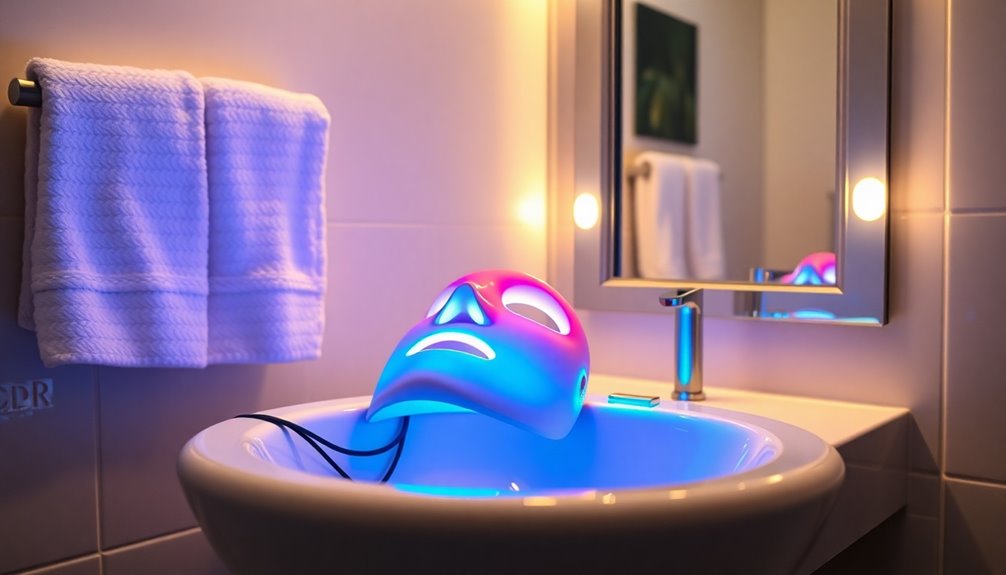
When considering LED face masks, it’s important to look at the scientific evidence available and how the quality of the device can impact your results.
Regular, consistent use is key to seeing any benefits, but keep in mind that not all masks are created equal.
You’ll want to make sure you’re choosing a reliable, FDA-approved option for the best outcomes.
Scientific Evidence Availability
Although many people are curious about the effectiveness of LED face masks, the scientific evidence supporting their use reveals a mixed picture. Here are three key points to evaluate:
- Clinical studies have shown that LED therapy can lead to subtle improvements in skin texture and may reduce fine lines.
- Professional devices tend to be more effective than at-home models due to targeted wavelengths and higher intensity.
- The efficacy of LED face masks varies based on individual skin conditions and the frequency of use.
While LED face masks can offer anti-aging benefits and are generally safe when using FDA-approved devices, long-term research is still needed to confirm their overall effectiveness, especially with blue light for acne treatment.
Device Quality Impact
The effectiveness of LED face masks is heavily influenced by the quality of the device you choose. Higher-quality LED masks typically emit more potent wavelengths, directly impacting their effectiveness for various skin concerns.
Clinical studies indicate that while affordable at-home options can yield subtle improvements in skin texture and wrinkles, they often lag behind professional devices used in dermatology offices. The device quality, including its construction and technology, plays a significant role in determining results.
Additionally, user compliance affects outcomes, as regular use is essential for achieving noticeable benefits. Unfortunately, the lack of extensive long-term studies leaves results uncertain, highlighting the importance of investing in a high-quality LED mask for better skin improvement.
Consistency of Use
To achieve noticeable improvements with LED face masks, consistency in use is key. Here are three essential tips for maximizing your results:
- Frequency: Aim for at least two to three sessions per week, or daily for ideal effects.
- Duration: Use your LED mask for 30-60 minutes each session to see significant changes in skin texture.
- Combination: Pair treatments with a thorough skincare routine for cumulative benefits.
Regular use can lead to visible improvements, such as enhanced skin tone and reduced fine lines.
However, remember that results can vary based on individual skin conditions and the quality of your device.
What Benefits Can LED Face Masks Provide?
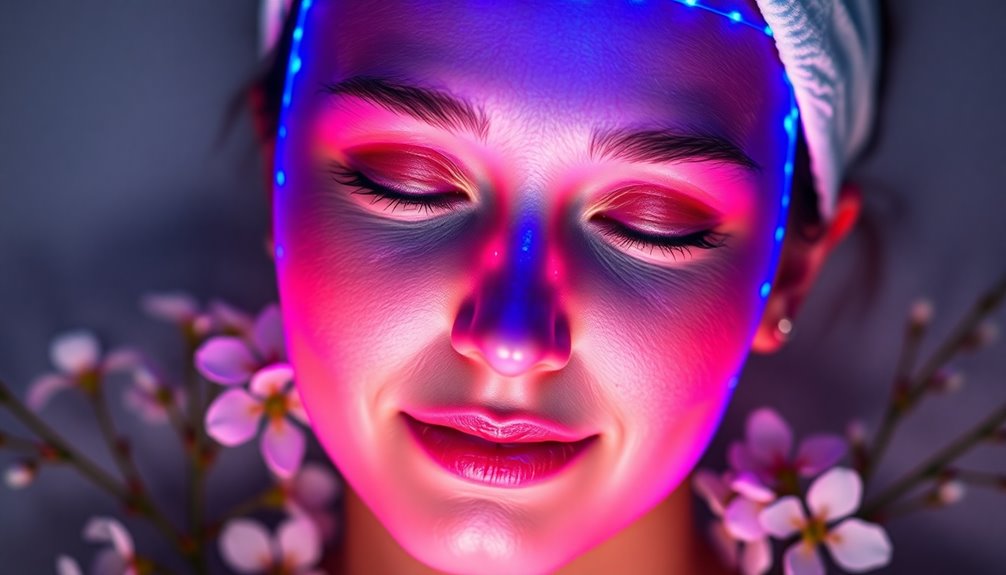
While exploring skincare options, you might find that LED face masks offer a range of benefits for your skin.
These masks promote collagen synthesis, enhancing elasticity and reducing the appearance of fine lines and wrinkles through red light wavelengths. If you struggle with acne, the blue light emitted targets and eliminates acne-causing bacteria, making it an effective treatment for acne vulgaris.
Additionally, regular use can improve overall skin texture and tone, with subtle improvements noted in clinical studies. The near-infrared light aids in wound healing and reduces chronic inflammation, benefiting various skin conditions.
Most LED face masks are safe for all skin types, as long as you follow manufacturer guidelines and prioritize eye safety during use.
Are LED Face Masks Safe to Use?
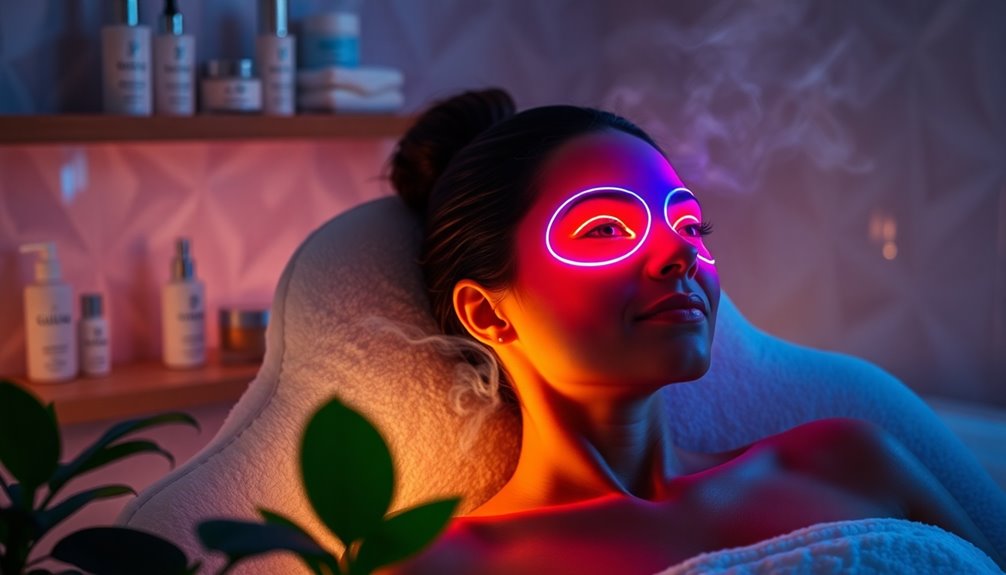
LED face masks can provide impressive benefits for your skin, but it’s important to evaluate their safety. Here are three key points to contemplate: LED face masks can provide impressive benefits for your skin, but it’s important to evaluate their safety. Here are three key points to contemplate: Firstly, consider the type of LED light used, as different wavelengths can produce varying results. Secondly, while many users report positive outcomes, individual skin types can respond differently; therefore, research into whether are LED masks effective for skin is crucial. Lastly, always perform a patch test before full application to avoid any adverse reactions.
- Consult a dermatologist: Before using LED face masks, especially if you have light sensitivity or pre-existing skin conditions.
- Use eye protection: This is essential when using blue light features to prevent potential eye irritation or damage.
- Follow manufacturer guidelines: Overuse can lead to side effects like skin irritation or redness, so stick to recommended usage.
Generally, LED face masks are deemed safe, especially those with FDA clearance.
However, monitor your skin’s reactions carefully and remain aware of any light sensitivity to guarantee a safe experience.
What Are the Potential Risks of Using LED Face Masks?
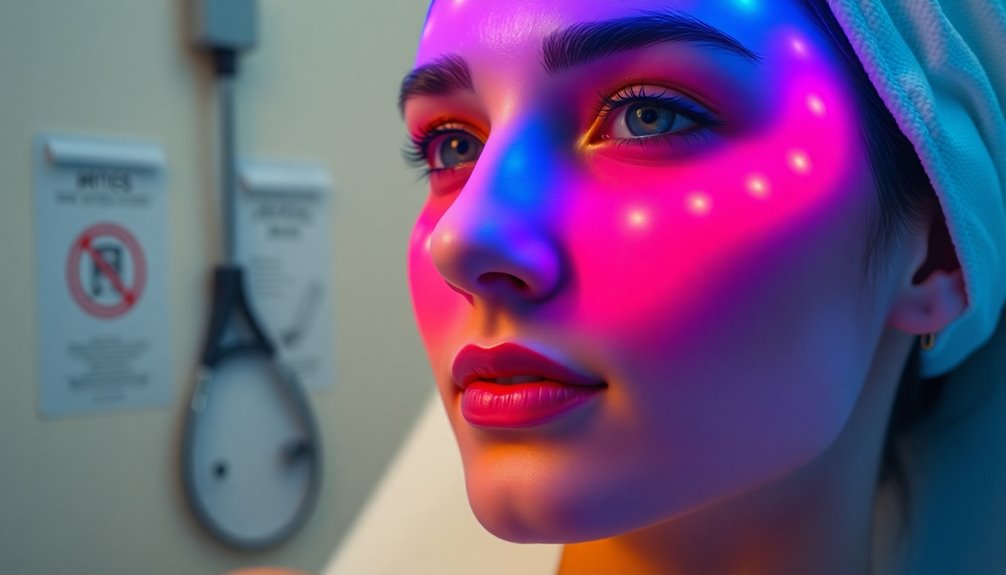
As you explore the benefits of LED face masks, it’s important to take into account the potential risks that come with their use. When purchasing an LED face mask, be aware of potential side effects like increased inflammation, rashes, or redness, especially from overuse or misuse.
Eye protection is significant during treatments, particularly with blue light wavelengths, to prevent damage. If you have light sensitivity or specific skin conditions, consult a dermatologist beforehand to avoid adverse reactions.
Long-term safety data is limited, so always follow manufacturer instructions for usage. Additionally, users with darker skin tones may face a higher risk of discoloration, making it critical to approach LED therapy cautiously and conduct further research on its effects.
How Do At-Home LED Face Masks Compare to In-Office Treatments?
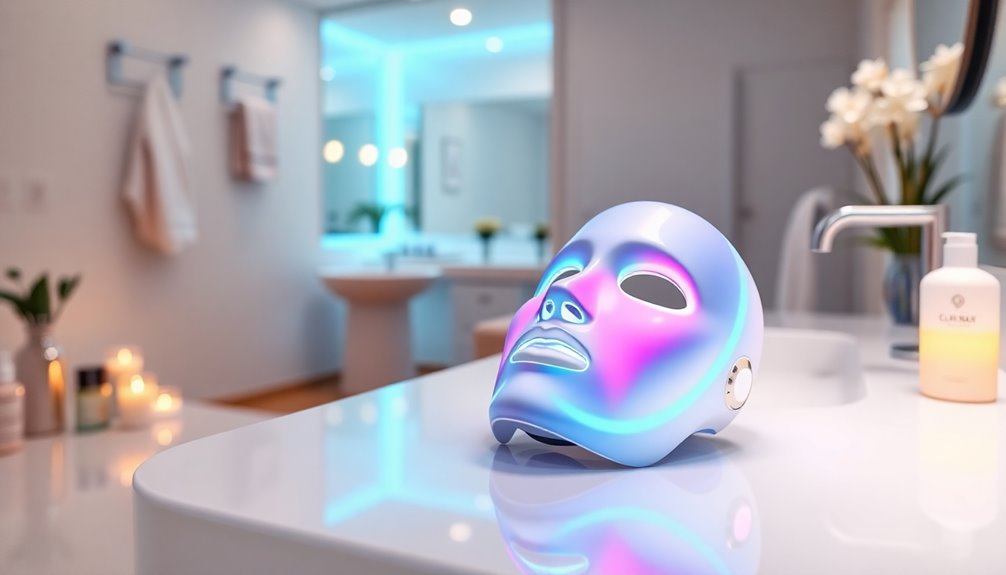
Using LED face masks can be a great addition to your skincare routine, but comparing at-home devices to professional treatments reveals significant differences.
- Effectiveness: In-office treatments use professional-grade devices that deliver more powerful light energy, resulting in immediate improvements in skin texture.
- Usage Frequency: At-home LED face masks usually require more frequent sessions—30-60 minutes multiple times a week—compared to less frequent professional visits.
- Safety Standards: In-office treatments adhere to stricter safety standards, while at-home devices rely on your adherence to manufacturer guidelines for safe use.
While at-home masks offer convenience, their benefits may take longer to manifest, and their efficacy varies widely based on device quality and clinical studies.
Is It Worth Purchasing an LED Face Mask?
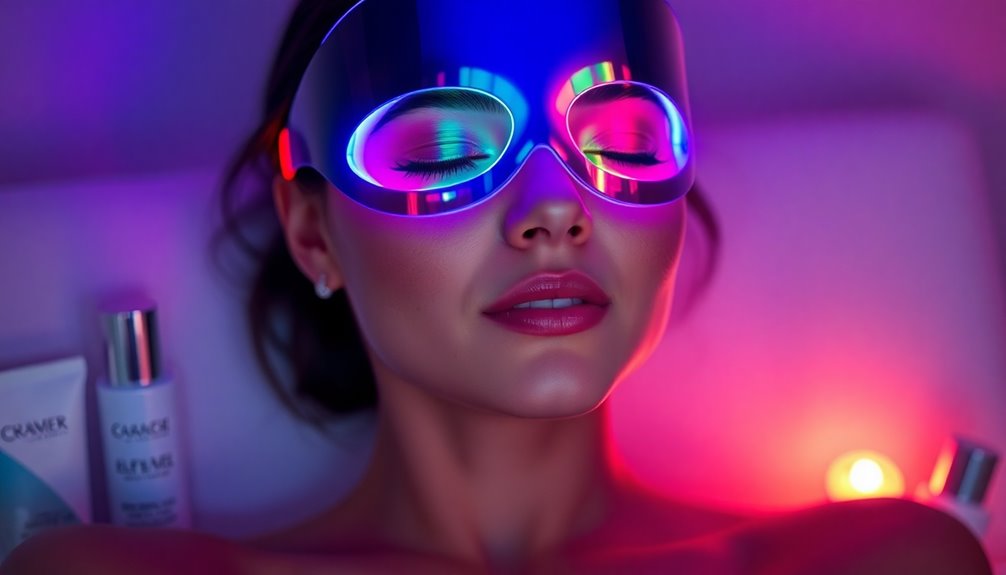
When considering whether to purchase an LED face mask, it’s vital to weigh the potential benefits against the investment.
LED face masks come in a wide price range, from under $50 to nearly $2,000, so assess your budget and expected results. While clinical studies show that at-home masks can yield subtle improvements in skin texture and fine lines, they’re generally less effective than professional treatments.
Verify the mask has FDA clearance to confirm safety and efficacy. Remember, consistent use is essential; experts recommend using the mask twice daily for 30-60 minutes to see noticeable results.
If you’re after significant improvements, you might want to think twice before purchasing, especially if you’re seeking results similar to those from professional treatments.
Who Should Avoid Using LED Face Masks?
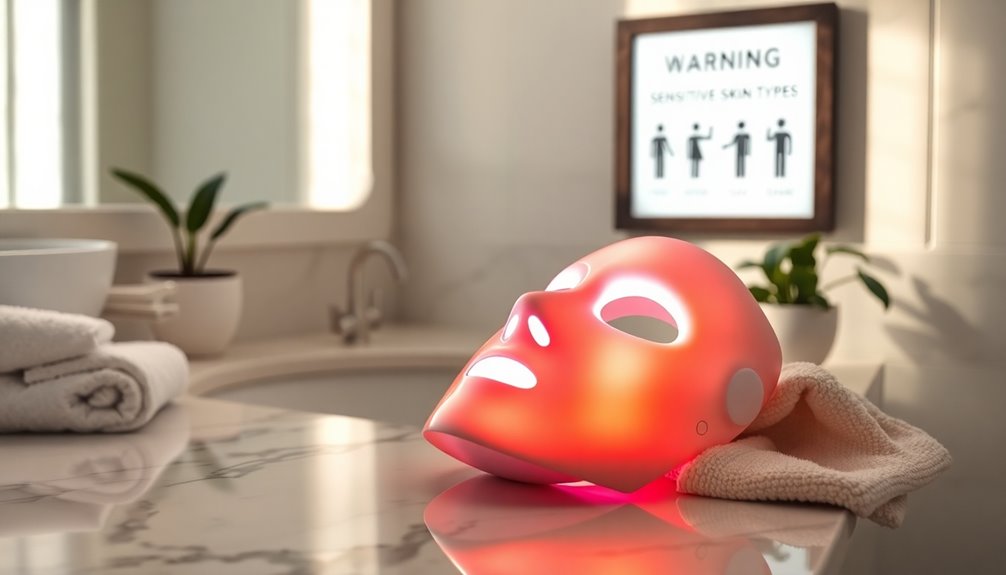
Certain individuals should definitely steer clear of using LED face masks to avoid potential skin reactions or health risks.
Here are a few groups to evaluate:
- Those with light sensitivity or conditions like lupus, as they may experience skin irritation.
- Individuals with active skin infections or open wounds, since the light can aggravate these conditions.
- Pregnant individuals and those with eye conditions like retinal disorders should consult a healthcare professional before use, as the effects aren’t well-studied.
Additionally, individuals with darker skin tones might face a higher risk of discoloration or irritation, so it’s wise to seek advice from a dermatologist before trying LED masks.
Always prioritize your skin’s health!
Frequently Asked Questions
Do LED Light Therapy Face Masks Really Work?
When you’re considering LED light therapy face masks, it’s important to know that their effectiveness can vary.
Regular use might lead to subtle improvements in skin texture and wrinkles, especially with red light for anti-aging or blue light for acne.
However, results depend on the mask’s quality and your skin type.
While they can be beneficial, they’re generally less effective than professional treatments, so keep your expectations realistic.
Do Dermatologists Recommend Red Light Masks?
If your skin could talk, it’d probably sing praises for red light masks!
Dermatologists often recommend these masks for their ability to stimulate collagen and reduce fine lines. They appreciate the anti-inflammatory benefits that promote healing and improve texture.
However, they caution you to choose FDA-cleared products for safety and suggest pairing them with professional treatments for the best results.
Regular use can lead to noticeable improvements, so it’s worth considering!
What Does the Mayo Clinic Say About Red Light Therapy?
The Mayo Clinic notes that red light therapy can improve your skin by reducing wrinkles and boosting collagen production.
It may enhance healing and reduce inflammation, making it useful for various skin conditions.
However, they stress that while some studies show positive effects, more research is needed to confirm its long-term benefits.
Before starting any treatment, it’s wise to consult a healthcare provider to ascertain it suits your individual skin type and needs.
What Are the Negatives of LED Light Therapy?
When it comes to LED light therapy, you might feel like you’re chasing rainbows, but there are some clouds to take into account.
You could experience increased inflammation, rashes, or redness, especially if you misuse the device. Long-term safety isn’t fully understood, so unknown risks linger.
If you have light sensitivity or specific eye issues, you might find discomfort. Plus, results can vary greatly depending on your skin type and device quality, leading to unpredictable outcomes.
Conclusion
To sum up, LED face masks can offer promising skin benefits, but it’s crucial to do your research before diving in. Did you know that a study found that over 70% of users noticed improvements in their skin texture after regular use? If you’re considering an LED mask, remember to weigh the benefits against potential risks. Ultimately, it’s about finding what works best for your skin type and needs. Happy glowing!
